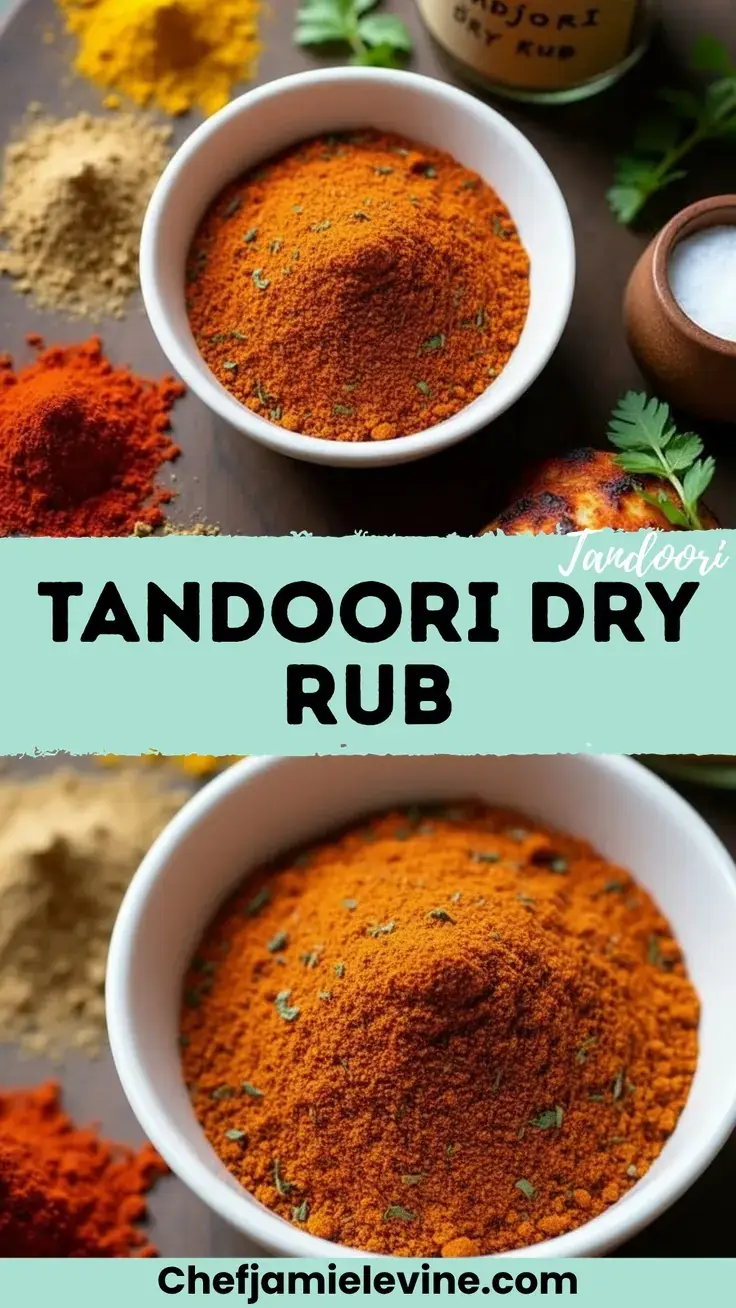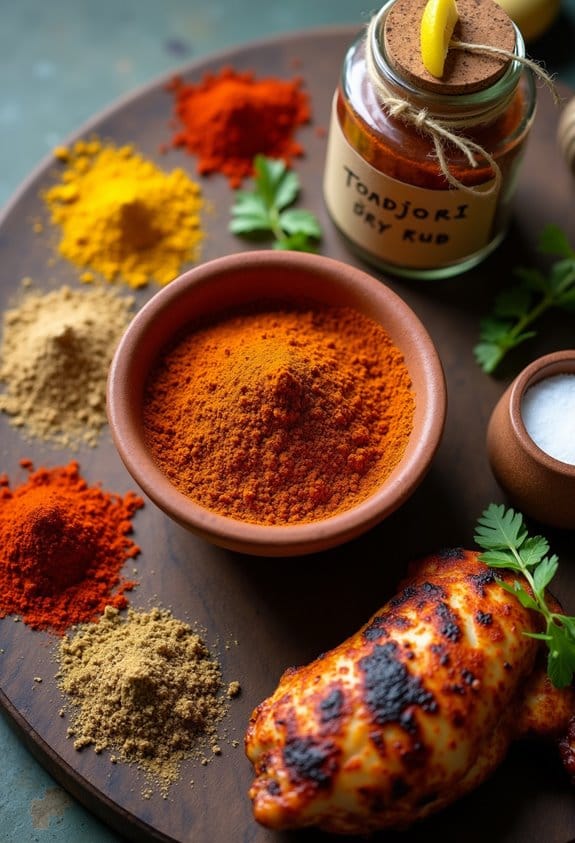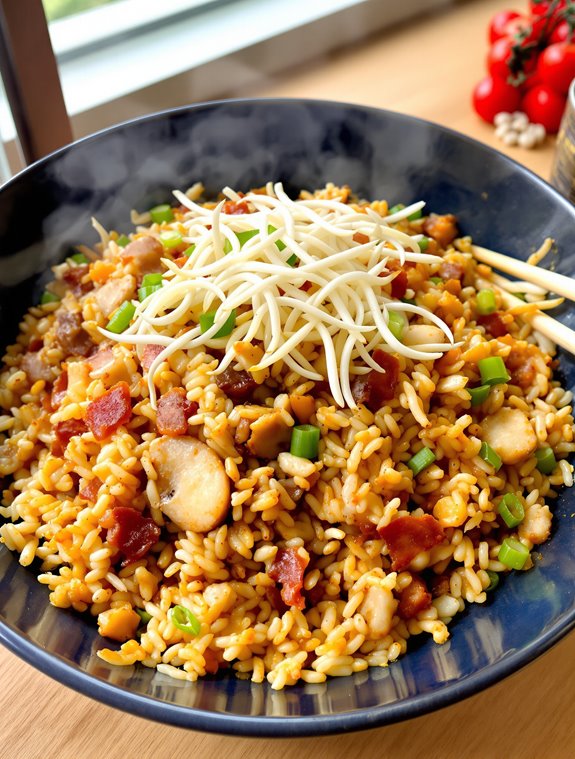Why You’ll Love this Tandoori Dry Rub
If you’ve ever been intimidated by the complex flavors of tandoori cooking, this dry rub is about to become your new kitchen best friend.
I created this blend after years of trying to nail that perfect balance of warmth, earthiness, and subtle heat that makes tandoori dishes so craveable.
What I love most? The versatility. It transforms everything from chicken thighs to cauliflower with minimal effort.
No more hunting down specialty ingredients or spending hours on marinades. Just a few teaspoons of this ruby-hued powder, and suddenly Tuesday night dinner has restaurant-worthy flavor.
Who knew weeknight cooking could taste this good?
What Ingredients are in Tandoori Dry Rub?
The beauty of this tandoori dry rub lies in its perfect balance of warm, aromatic spices that create that signature tandoori flavor without needing a clay oven.
I’ve tested countless variations to find just the right proportions that deliver authentic taste with ingredients you probably already have in your spice cabinet. This blend captures the essence of traditional tandoori seasoning while being incredibly versatile for all sorts of proteins and vegetables.
- 2 teaspoons ground turmeric
- 2 teaspoons ground cumin
- 2 teaspoons sweet paprika (or substitute part with Kashmiri chili for deeper color)
- 1 teaspoon ground ginger
- 1 teaspoon ground coriander
- ½–1 teaspoon cayenne pepper (adjust to your heat preference)
- 1–1½ teaspoons kosher salt
- Optional: ½ teaspoon garlic powder
- Optional: ½ teaspoon smoked paprika (for subtle smokiness)
The color of your tandoori rub matters almost as much as the flavor. The combination of turmeric and paprika creates that signature reddish-orange hue that makes tandoori dishes instantly recognizable.
Want a more vibrant red? You can add a pinch of beet powder or use Kashmiri chili powder, which deepens the color without adding excessive heat.
And don’t worry about the salt level—I’ve suggested a range so you can customize based on your dietary needs or the other ingredients in your final dish.
How to Make this Tandoori Dry Rub

Making this tandoori dry rub couldn’t be simpler, which is part of its charm. Start by gathering all your spices—2 teaspoons ground turmeric, 2 teaspoons ground cumin, 2 teaspoons sweet paprika, 1 teaspoon ground ginger, 1 teaspoon ground coriander, ½–1 teaspoon cayenne (depending on your heat tolerance), and 1–1½ teaspoons kosher salt. Don’t forget those optional additions if you’re using them: ½ teaspoon garlic powder and ½ teaspoon smoked paprika for that subtle hint of smokiness. The beauty of dry rubs is in their simplicity—just measure, mix, and you’re done.
Once you have all your spices measured out, simply whisk them together in a small bowl until they form a uniform mixture. No clumps, no streaks, just a beautiful reddish-orange blend that promises incredible flavor. The whisking part matters more than you might think; those little pockets of cayenne or salt can lead to uneven seasoning later.
When thoroughly mixed, transfer your spice blend to a clean, dry jar—moisture is the enemy of longevity when it comes to spice blends. Label it with the date (and maybe the name, if you’re making multiple spice blends). This tandoori rub will keep its potency for about 3 months if stored in a cool, dark place.
When you’re ready to use your tandoori rub, remember that a little goes a long way. For chicken thighs, you’ll want about 1–1½ teaspoons per piece. If you’re seasoning fish or shrimp, use about 1 teaspoon per 6 ounces. For vegetables like cauliflower florets, go with 1–1½ tablespoons per pound.
The key to maximum flavor is patting your protein or vegetables dry first, then drizzling with a touch of oil so the spices have something to cling to. For the classic tandoori experience, mix ½ cup plain yogurt with 1 tablespoon lemon juice and 1–1½ tablespoons of your rub per pound of chicken, then let it marinate anywhere from 30 minutes to 12 hours before cooking. The yogurt not only adds flavor but also tenderizes the meat beautifully.
Tandoori Dry Rub Substitutions and Variations
Every kitchen disaster I’ve faced has taught me one thing—adaptability saves dinner.
When you’re halfway through prepping tandoori chicken and realize you’re out of ground ginger, don’t panic. A bit of fresh ginger (finely grated) works beautifully, or even ginger paste in a pinch.
No sweet paprika? Regular paprika plus a tiny pinch of sugar creates that same depth.
And if heat isn’t your thing, simply reduce the cayenne or swap it for black pepper.
My personal favorite variation? Adding a touch of cinnamon and clove during winter months.
Creates the most aromatic, warming profile that’ll make your kitchen smell divine.
What to Serve with Tandoori Dry Rub
When planning a meal around tandoori-spiced dishes, complementary sides make all the difference. I love serving cool cucumber raita—that creamy yogurt dip balances the warm spices perfectly.
Fluffy basmati rice or warm naan are must-haves for soaking up those delicious flavors.
For vegetables, try a simple tomato-onion salad with a squeeze of lemon, or roasted cauliflower tossed in the same tandoori rub.
Want something invigorating? A mint-coriander chutney works wonders.
Remember those lemon wedges I mentioned earlier? They’re non-negotiable, trust me. The bright acidity cuts through the richness and makes every bite sing.
Final Thoughts
This tandoori dry rub has become a staple in my kitchen for good reason. It transforms ordinary proteins into vibrant, flavor-packed meals with minimal effort.
I love how versatile it is—perfect on everything from chicken thighs to roasted cauliflower, and even better when mixed with yogurt for that authentic tandoori experience.
What I appreciate most is how it brings restaurant-quality Indian flavors home without specialty equipment. Keep a jar on hand, and you’re always 20 minutes away from dinner magic.
The balance of warming spices, gentle heat, and that gorgeous color? That’s what makes cooking feel like a small victory every time.

Homemade Tandoori Dry Rub
Ingredients
Equipment
Method
- Gather all your spices and measuring tools.
- Measure all spices into a small bowl.
- Whisk the spices thoroughly until completely combined with no clumps or streaks, creating a uniform reddish-orange mixture.
- Transfer the spice blend to a clean, dry airtight jar or container.
- Label with the date and store in a cool, dark place for up to 3 months.



